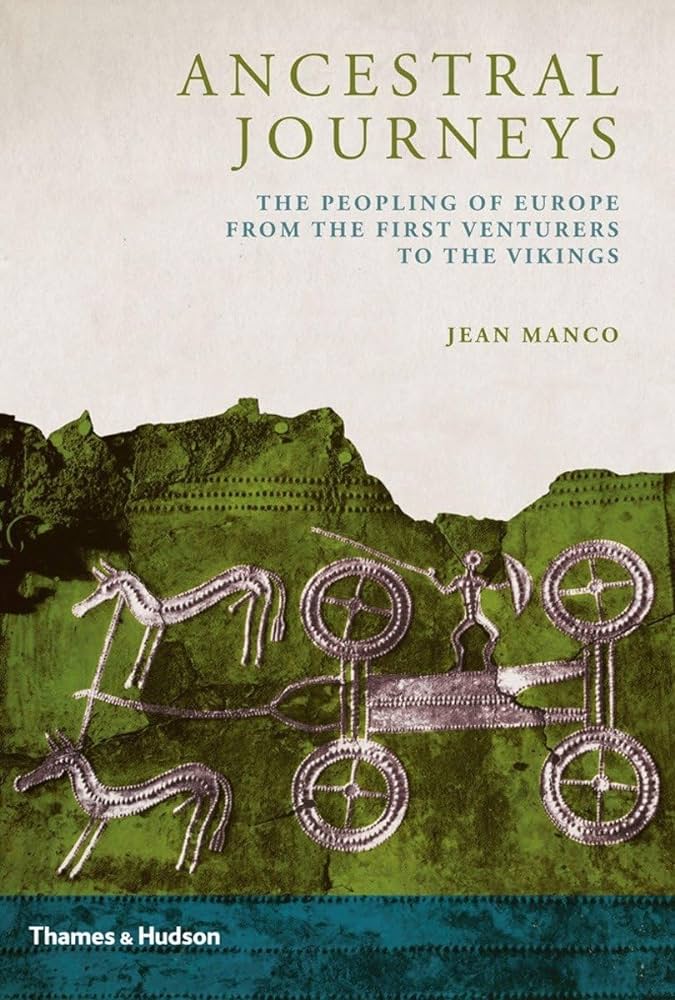|
Ancestral Journeys: The Peopling of Europe from the First Venturers to the Vikings
By Jean Manco Published in October 2013 304 Pages Thibault’s Score: 3/5 Ancestral Journeys is a book that explores the ethnic origins of Europe. The book uses the latest genetic, archeological, and linguistic sources to explain the peopling of Europe The book is divided into two parts. The first part explores the underlying scientific methods used; and the second discusses the actual historical population changes in Europe. The first part of the book is the most interesting. Instead of covering human population movements, it focuses entirely on explaining the underlying science. This part of the book was very interesting, and helped me get a much better understanding of genetics. The second part covers the population movements of Europe from the Mesolithic until the vikings. For example, it explains the destruction of the paleolithic monument builders of Britain at the hands of the Indo-Europeans steppe peoples. The sheer amount of movements of people, lists and haplogroups, etc… made it very repetitive and uninteresting. The book gave a really clear explanation of the utility and downsides of DNA testing. For example, it explains how Y-DNA is only found in patrilineal lines - it is only present in males, and passed from father to son. Mitochondrial DNA - or mtDNA - always comes from the mother. Every time someone is born and cells divide, mutations appear. The vast majority of mutations have no or almost no effects on the person inheriting them. These mutations can be tracked, which allows you to determine if two people were distantly related, and gives you a very approximate idea of when. DNA testing is very limited. When DNA testing was first discovered, scientists and archaeologists made many assumptions that led them to make mistakes. It was falsely believed that the mutation rate in between generations was constant. This meant that if you had an approximate estimate of how many mutations occur every generation, you could estimate the time at which two distant relatives were related. Later testing revealed that mutation rate in between generations varies depending on climate, genetics, and many environmental factors. As a result, many of the earlier findings were overturned. There are many other limitations. An isolated individual might travel a great distance, and end up in a population that is very far away. He may have many children, and those children might also be abnormally successful. As a result, a Y Haplogroup or mtDNA marker might be found in a population suggestive of a migration; but may only be the result of chance. Despite its limitations, population genetics still has enabled many important new avenues of historical and archeological research. Since the late 18th century, linguists have started proposing links in between languages. Linguists posited for example that many seemingly unrelated languages in Eurasia originated from a single group of steppe nomads that conquered the continent and replaced roughly half of Eurasia’s people. Evidence stemmed when linguists noticed similarities between distant languages such as Hindi and Welsh. By making lists of words, and seeing which languages shared which words, linguists came up with theories of interrelatedness which allowed them to make demographic predictions. Suppose that European languages such as Welsh, Russian, and French share the word for “Bronze” while Central Asian languages such as Hindi, Iranian, and Kazakhs share a different word. This suggests that the population that was at the root of these groups split before Bronze was invented. As a result, in the early 20th century, linguists developed theories about prehistoric population movements. In the 1970s, the tide of scientific opinion shifted, and linguistic evidence as a tool for tracing populations fell out of favor. Population genetics overturned the 1970s consensus, and verified that at least some of the linguistic theories about population movements seemed valid. Most significantly, the existence of the Indo-Europeans was proven. Almost all Eurasian populations that spoke an Indo-European language before the colonial era were found to be related to a group which archeologists call the Yamnaya. The name comes from their burial pits, and little is known about their language. They lived as steppe nomads around 3300 BC. It is unclear whether they rode horses or just used them as food and beasts of burden. Their “Yamnaya” style tombs can be found in eastern Ukraine and Russia. Over time, the Yamnaya fractured. Different groups very slowly, century by century, began migrating to different areas of Eurasia. They in turn fractured, then migrated. This process resulted in the spread of languages, ethnicities, and DNA of modern Eurasia. I recommend reading the first half of the book to understand how the underlying science of population genetics works. The second half was interesting, but would be hard to follow without significant additional research.
0 Comments
Leave a Reply. |
Thibault SerletMost of my articles are book reviews, but I also write about many other topics. Archives
December 2023
Categories |

 RSS Feed
RSS Feed